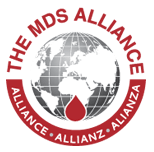Hooray for VIDAZA
Home Demo › forums › Patient Message Board › Hooray for VIDAZA
- This topic has 8 replies, 1 voice, and was last updated 18 years, 1 month ago by
Dennis.
-
AuthorPosts
-
March 11, 2006 at 7:14 pm #12261
JulesH
MemberListed below is the best description of my disease that I have found to date.
I have increased the white cell production, my blasts were above 6% and I was tx dependent for 4 months( 2 units weekly).
I began VIDAZA over 18 months ago with injections on 4 week cycles. After about 6 months I went to 6 week cycles and am currently on my 3rd 8 week cycle.
I have both myeloproliferative and myelodysplastic diseases.
Currently my blasts are less that 1%, I have been tx independent for 15 months and have survived 33 months which is well past the 24 month median mentioned below.
I was told by my NP at Moffitt Cancer Center that VIDAZA has been found to prevent reticulin fibrosis, which is an unexpected plus.
I played 4 rounds of golf last week, not very good rounds, but I played.
If your symptons match mine and your DR. has not mentioned VIDAZA, ask him about it.
Good Luck to all,
JulesH
Clinics and Pathology
Disease The defining features of CMML are an absolute monocytosis of >1X109/l, increased numbers of monocytes in bone marrow, and a variable degree of dyplasia in all three lineages. Myeloblasts and promonocytes comprise less than 5% of nucleated cells in peripheral blood and less than 20% of cells in bone marrow. Roughly half of patients present with an elevated white cell count that is commonly associated with hepatomegaly and splenomegaly, the so-called myeloproliferative form of the disease. Patients lacking these features are generally considered to have the myelodysplastic form of the disease.
Phenotype / cell stem origin Presumably a multipotential stem cell.
Epidemiology CMML is usually a disease of older adults althought the disease also occurs in children, where distinction from juvenile chronic myelogenous leukemia (JCML, also known as juvenile myelomonocytic leuekmia) is difficult, and at times impossible. In one series the median age for the myelodysplastic type was 70 and for the myeloproliferative form 72 years. The disease shows a distinct male predominance of 1.6-2.1:1.
Clinics CMML patients may present with hepatomegaly or splenomegaly, serous effusions or other sites of extramedullary involvement such as skin or, less commonly, gums.
Cytology Blood: The peripheral blood count may be increased or decreased. By definition monocytes and promonocytes exceed 1X109 /l. Dyplastic monocytes or neutrophils are usually evident. Normocytic or macrocytic anemia is common as is thrombocytopenia, which is usually mild. Serum lysozyme is usually elevated and immunoglobulin elevations occur in about a third of patients, with monoclonal gammopathy in about 5-10% of patients.
Bone marrow: The bone marrow is almost always hypercellular, often with trilineage dysplasia. Myeloblasts and monoblasts are less than 20% of the total cellularity. About 30% of cases show significant reticulin fibrosis. Cases associated with the t(5;12) (see below) are commonly associated with eosinophilia.Treatment Although CMML often initially respond to conventional chemotherapy, complete responses are rare. Allogeneic bone marrow transplantation is potentially curative for those patients who are eligible.
Prognosis The median survival for patients with CMML is about 24 months. There does not appear to be a difference in survival between patients with the myeloproliferative versus the myelodysplastic forms of the disease nor are the number of blasts of prognostic value. Of adult patients who underwent allogeneic bone marrow transplantation the disease-free survival was 39% at 3 years.March 11, 2006 at 7:18 pm #12262JulesH
MemberSorry, the 2nd sentence should read
I have the increased white cell production,……
JulesH
March 11, 2006 at 11:30 pm #12263Suzanne
MemberHooray for you!
Enjoy that golf. I guess where you are you don’t need to wait for warmer weather!March 12, 2006 at 2:27 am #12264Terri
MemberJules where in Florida are you, Bob has been on For 1 and 1/2 years on the vidaza. He started and the blast went down, His counts started holding but then the whites started increasing again and after Hurricane wilma the others came down so we are back on the 28 off 7 on cycle.
No tx since dec 03, have come close – his hgb was 8.4 this past Monday will see this Monday. Bob has been very weak, especially this is his week on.
I am so very happy to hear you are doing well.
We are looking forward to a long weekend away shortly. Hope Bob’s counts come up so he isn’t so tired
God blessMarch 12, 2006 at 2:48 am #12265CarolineG
MemberJules,
Wonderful News !!!! Enjoy your health and your golf. Keep playing. Your game will come back.
Blessings,
CarolineMarch 12, 2006 at 6:33 am #12266JulesH
MemberI am in the Tampa Bay area of Florida.
My HGB goes down to about 8.0 10 days after my
VIDAZA during each 8 week cycle but it then goes up to 9.5 or 10.0 before next cycle begins.I have found that if I have minor surgery, such as a skin cancer removed, my HGB dips. Dr. says trauma will do that.
I also have given up all alchohol products as my Dr. says alchohol inhibits the bone marrow functions.
I have about 6 very good weeks out of each 8 and the other 2 are bearable.
March 12, 2006 at 6:54 am #12267diner
MemberHi Jules,
I envy your warm weather. I’m glad you are doing good. Unfortunately the Vidaza didn’t help me and I have needed red cells more often since I was on it and my platelets stayed lower. I’m on Thalidomide now (only 1 1/2 months so far) and am starting Exjade, the new iron overload pill. I’m looking forward to some good weeks and less visits to the doctors. I’m ready for some warm weather. Hope you continue to do well.
Hope you continue to do well.Dee
March 15, 2006 at 6:16 am #12268Jack_dup1
MemberHi Jules,
Glad to see your positive results from vidaza, it is good to see someone ahead of the prognosis, I was diagnosed 4/28/2003, my 60th Birthday. I still have not had any treatment. I don’t think Vidaza will help me because of my WBC being at 45.8, my reds are normal and platelets about 80,000.
JackMarch 15, 2006 at 3:52 pm #12269Dennis
MemberWell, Vidaza’s been good for me. With the exception of platelets, all counts are in the low end of normal, and platelets around 112, so they’re not worried. I’ve had 8 rounds of 7 on 21 off (just finished 8) while awaiting the right donor for a transplant.
Dennis
-
AuthorPosts
Register for an account, or login to post to our message boards. Click here.
- You must be logged in to reply to this topic.









